US Mobile Virtual Network Operators (MVNO) Market Size
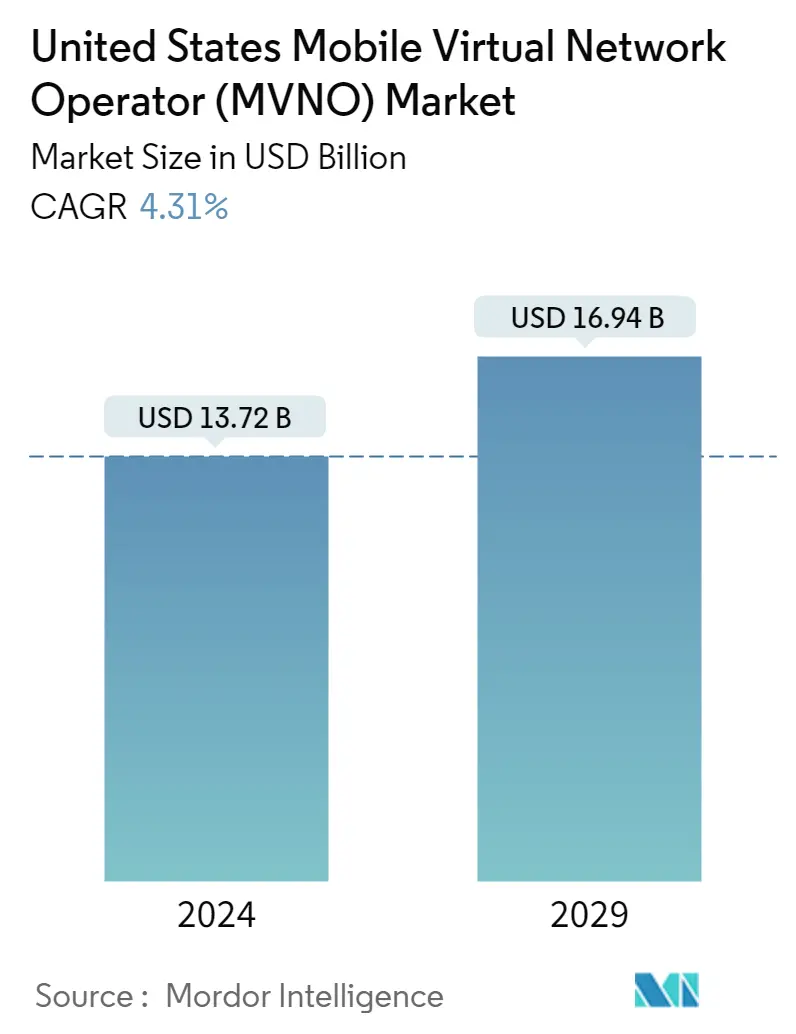
| Study Period | 2019 - 2029 |
| Base Year For Estimation | 2023 |
| Market Size (2024) | USD 13.72 Billion |
| Market Size (2029) | USD 16.94 Billion |
| CAGR (2024 - 2029) | 4.31 % |
| Market Concentration | Medium |
Major Players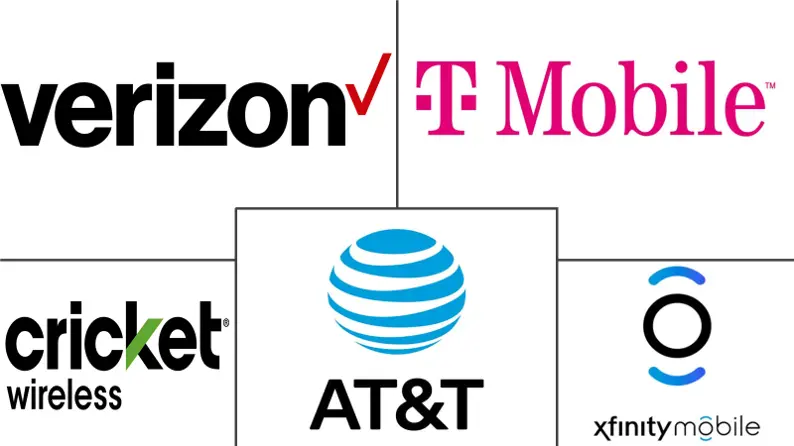
*Disclaimer: Major Players sorted in no particular order |
US Mobile Virtual Network Operators (MVNO) Market Analysis
The United States Mobile Virtual Network Operator Market size is estimated at USD 13.72 billion in 2024, and is expected to reach USD 16.94 billion by 2029, growing at a CAGR of 4.31% during the forecast period (2024-2029).
The mobile virtual network operator (MVNO) market in the United States is considered mature and developed. The MVNOs first started operation in the United States in 2011. Since then, the MVNO market has had prolonged growth compared to the increase in the number of mobile subscribers. The United States has four major carriers, which provide network infrastructure to 139 MVNOs who serve their 36 million active subscribers as of April 2019, as reported by GSMA. MVNOs flourished in the United States due to the Lifeline program run by FCC in the United States. The major States in the United States have partnered with a few MVNOs to provide mobile and broadband services at a very subsidized rate.
- Mobile virtual network operators (MVNOs) are facing a wave of change as evolving demand and competition, and technology advancements bring the latest opportunities and challenges for MVNOs and their mobile network operators (MNO) hosts. The US mobile market is moving towards saturation and a crossed 80% penetration rate during 2019 with big companies such as T-Mobile, Verizon, and AT&Tcommanding significant share of the country's user base. In the US, MVNOs are increasingly becoming a means of bringing additional segments into the subscriber base on to the host operator network via focusing on specific value propositions for niche target segments of customers. MVNOs are one of the faster, cheaper entry approaches compared to building a network with the comparatively cost-effective service offering from MVNOs the services are popular amongst the users of used and refurbished handset users in the country.
- As the wireless telephone subscription reaches the level-off point, the country's growing propensity towards data usage fuels the growth of MVNOs where big four MNOs in the country are pushing to gain from the MVNOs user base. According to ACSI, customer satisfaction with full-service MVNOs was higher than that of MNOs during 2019, which stood at 77 compared to MNO's 73. Cricket Wireless, Metro by T-Mobile, Virgin, and Boost were amongst the top with Cricket Wireless topping the category with 79 points and over 10 million subscribers. The company achieved this feat by offering the best in range wireless plans among full-service MVNOs. BYODs are another driving factor pushing the market growth in the country and enterprise-scale adoption and an entry point for MVNOs in the lucrative postpaid market.
- The MNVO market is also witnessing mergers in the United States. For instance, in July 2020, DISH announced today that it had completed its USD 1.4 billion acquisition of Boost Mobile. With this acquisition, DISH officially enters the retail wireless market, serving more than nine million customers. Boost was previously operated and owned by Sprint. Following the Sprint and T-Mobile merger, in April 2020, DISH has acquired Boost Mobile. In July 2019, DISH announced a series of agreements it reached with the DOJ and FCC as part of the merger between Sprint and T-Mobile. DISH network got access to the T-Mobile network for seven years, including the ability to serve DISH customers between DISH's forthcoming standalone 5G network and T-Mobile's nationwide network first-of-its-kind in the United States. DISH continued to make progress on its 5G network deployment and announced Fujitsu's selection for radio units.
- To ensure business continuity due to the COVID-19 outbreak, business organizations, especially in profoundly affected countries, allow their employees to work from home (WFH). The increase in people working from home has led to the rise in demand for downloading, online video viewing, and communication through video conferencing, leading to increased network traffic and data usage. T-Mobile has multiplied its low-band 4G capacity by up to six times to support working and schooling from home. This will continue until the pandemic ends. Thus, MVNOs, which are using T-Mobile's and other similar networks, are expected to play a crucial role in supporting the US's networking infrastructure. In March 2020, Cricket Wireless launched a new USD 15 plan with 2GB data and unlimited talks and texts without any activation given COVID-19 impact for a limited period that will expire in May 2020.
US Mobile Virtual Network Operators (MVNO) Market Trends
This section covers the major market trends shaping the US Mobile Virtual Network Operator Market according to our research experts:
Rising Demand for Efficient Cellular Network is Expected to Drive the Market
- The rising demand for an efficient cellular network is a significant factor driving the need for MVNOs in the market. Growing internet and smartphone penetration and the need for high speed around the globe, are forcing customers to opt for the most efficient network operator. The growing number of connected devices, machine to machine communication, cloud, IoT, Industry 4.0 and edge computing, among others, are some of the market trends that are making it necessary to adopt high speed and efficient networks. Also, factors such as the increasing use of advanced devices and increasing network speed have led to high growth in the use of data applications such as video streaming and internet browsing in the United States.
- Owing to the digital transformation in the United States, its is expected that MVNOs would target IoT and machine-to-machine (M2M) and connectivity. These providers would aid in expanding out-of-the-box connectivity bundled in with devices and other services in the everything connected world: vehicles, medical devices, wearables, industrial equipment, etc. The data transmitted during the M2M connection is very low due to which the IoT device providers tend to prefer operators who could provide attractive pricing and packages. MVNOs, due to their business model, are best suited to serve this industry and will further increase their penetration in this segment in the future.
- The United States is witnessing a significant rise in connected devices. Network operators such as AT&T and T Mobile in their annual reports mentioned vital subscribers to these devices. AT&T reported 30% of its total subscribers in 2018 were for the connected devices. The country has seen the highest penetration of these connected devices in recent years and holds a considerable chunk in the North American market for the number of IoT devices. According to the GSMA, the number of IoT connections in North America is expected to grow to 5.9 billion by 2025. According to the American Tower Corporation, in 2019, there were an estimated 815 million mobile-connected devices in the United States.
- According to Ericsson, the number of 5G subscriptions in North America is expected to increase from 1 million in 2019 to 324 million in 2025. Based on a virtualized infrastructure, 5G offers the ability to ‘slice’ the network and assign each part a specific quality of service, to fit a use case. The rising penetration of 4G, 4G+, and 5G technology will also transform the business models of mobile operators and MVNOs. Features like network slicing will allow MNVOs to run ‘mini-networks,’ for customers in specific sectors. This offers the ability to target several vertical markets and applications, opening up opportunities for MVNOs. For instance, an MVNO-run branded mobile network for gaming requires lower latency and higher bandwidth. Network slicing will be beneficial for this.
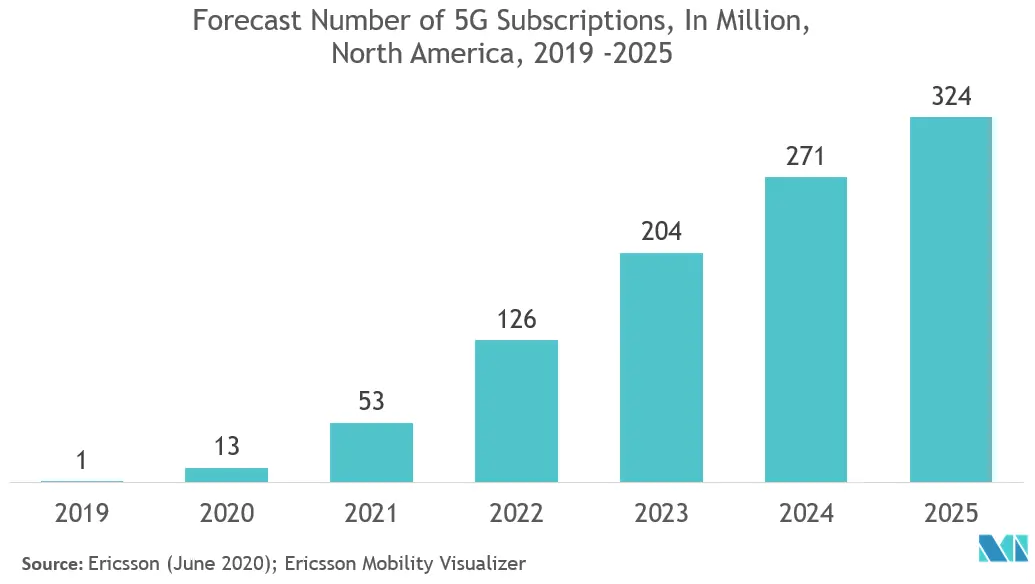
Resellers are Expected to Hold Significant Share
- Resellers are the third-party arrangement, selling a provider/operator's services and piggybacking a standard service SLA. One bill is issued through the overall service provider or operator. A reseller MVNO will either operate under its brand or co-brand with the MNO. Mostly, the branded reseller brings brand distribution channels or a large existing customer base to the table, from which it can leverage its sales. The choice of an operational model for the MVNOs is highly influenced by the operators' willingness for the associated risks and the cost of operations. The business process makes the MVNO market more of a business with less capital expenditure estimated at around USD 3.5 million and peak project funding estimates in the range of USD 6 million to USD 8 million.
- Using the reseller model, an MVNO can potentially offer its value-added services (VAS). The limited liability makes this market segment associated with fewer risks for the MVNO and limits revenue opportunity, due to lack of control on operations. In this business model, the MVNOs hold no assets in the partnership with the MNO's, i.e., they get no ownership of the client, the infrastructure, or the SIM and cannot set prices. The mobile reseller is for those companies that want to provide a tailor-made mobile communication tariff to their customer base. At the same time, the branded reseller is for companies that want to enrich their brand with mobile communication services.
- The branded reseller model enables the MVNO to reap the benefits of operating under its brand or, in some instances, co-branded with the MNO. The reseller (branded) is liable for the costs of branding, sales, and distribution, and shares revenues with the partner MNO. The clients in this market belong to the MNO's. Revenue margin is estimated to lie in the range of 10-15% for the resellers. Branding, sales, and marketing are under the reseller scope, and the operational capability to handle the customer care services may be partially present or absent depending on the business agreement. Moreover, resellers take less time to market and require low startup costs, as no investment in MVNO infrastructure is needed because the network operator handles most of it. The reseller MVNO is also responsible for the costs of marketing, sales, and distribution.
- With the growing adoption of 4G and 5G technology, the reseller model is expected to have a tremendous opportunity over the forecast period. For instance, in January 2020, a new MVNO was launched to the public under Venn Mobile. The MVNO is run by the same organization of T-Mobile business plan reseller, Teltik. The plan costs USD 30 per month and comes with unlimited talk, text, data, and 50GB of mobile hotspot. The 5G wireless transformation wave continues. It impacts the wireless industry and a growing number of other sectors as well. Many MVNO players like Google Fi, Xfinity Mobile, Spectrum Mobile, Altice Mobile, Tracfone, StraightTalk, and many smaller companies are continuing with intense usage, which implies a significant growth going forward.
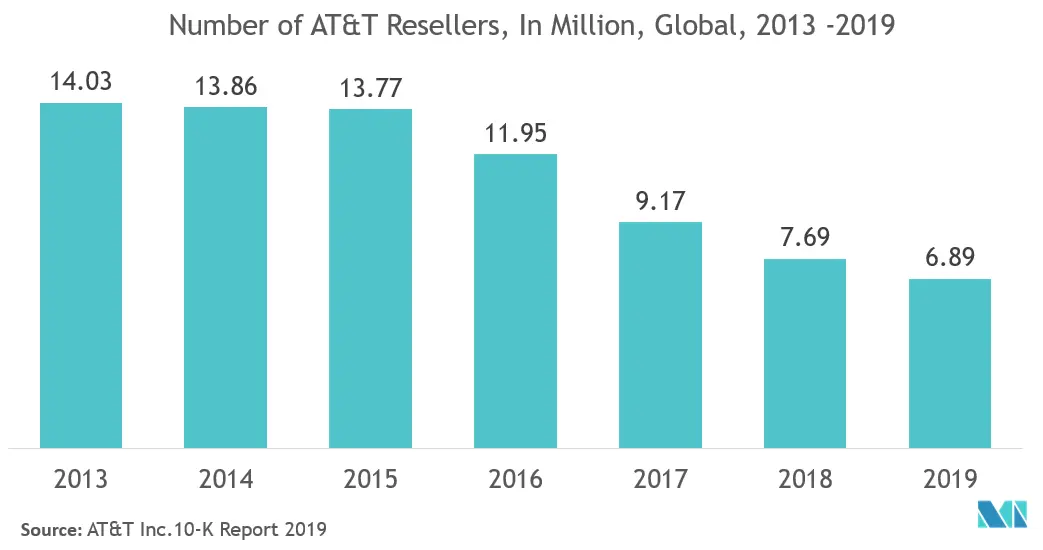
US Mobile Virtual Network Operators (MVNO) Industry Overview
The United States Mobile Virtual Network Operator (MVNO) is moderately fragmented with the presence of significant players such as Verizon Communications Inc., AT&T Corporation, T-Mobile USA, INC., Cricket Wireless LLC., Xfinity Mobile (Comcast Corporation), etc. Owing to growing competition and price pressures, MVNOs are innovating on value proposition and cost structure.
- July 2020 - Cricket Wireless announced the launch date for 5G wireless. On August 21st, customers can activate 5G service on the network. Cricket's first 5G device to become available for purchase will be the Samsung Galaxy S20+ 5G. Cricket's USD 40 plan got more data, and its USD 55 unlimited plan got a speed boost.
- May 2020 - Comcast launched new data plans with 5G services included free, regardless of how customers choose to pay for their data, whether it's unlimited or by the gig. Comcast is offering 5G on all its Xfinity Mobile plans. Xfinity Mobile is Comcast's mobile virtual network operator (MVNO) service that rides on Verizon's network.
US Mobile Virtual Network Operators (MVNO) Market Leaders
-
Verizon Communications Inc.
-
AT&T Corporation
-
T-Mobile USA, INC.
-
Cricket Wireless LLC.
-
Xfinity Mobile (Comcast Corporation)
*Disclaimer: Major Players sorted in no particular order
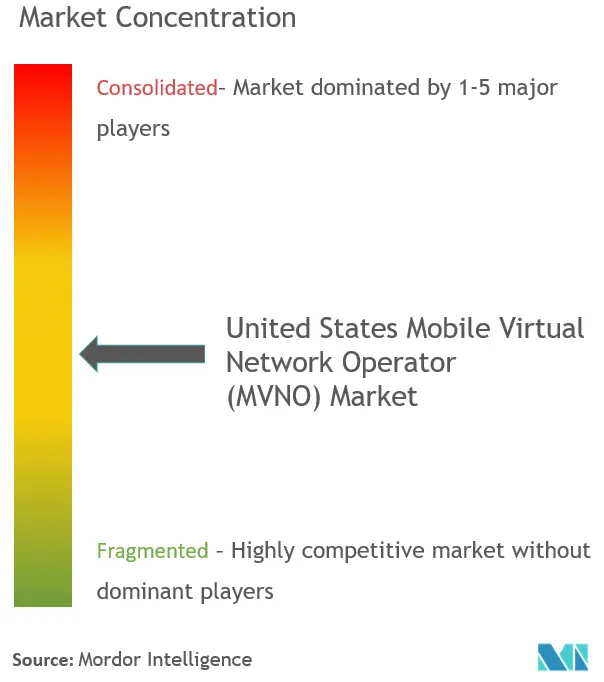
US Mobile Virtual Network Operators (MVNO) Market Report - Table of Contents
1. INTRODUCTION
- 1.1 Study Assumptions and Market Definition
- 1.2 Scope of the Study
2. RESEARCH METHODOLOGY
3. EXECUTIVE SUMMARY
4. MARKET INSIGHTS
- 4.1 Market Overview
- 4.2 Industry Value Chain Analysis
-
4.3 Industry Attractiveness - Porter's Five Forces Analysis
- 4.3.1 Bargaining Power of Suppliers
- 4.3.2 Bargaining Power of Buyers
- 4.3.3 Threat of New Entrants
- 4.3.4 Threat of Substitute Products
- 4.3.5 Intensity of Competitive Rivalry
- 4.4 Technology Snapshot
- 4.5 COVID-19 impact on the MVNO market
5. MARKET DYNAMICS
-
5.1 Market Drivers
- 5.1.1 Increasing Mobile Network Subscribers and the Growing Penetration Of Data Users
- 5.1.2 Rising Demand For Efficient Cellular Networks
-
5.2 Market Challenges
- 5.2.1 Fragmented Nature of the Market which is very competitive
6. MARKET SEGMENTATION
-
6.1 By Operating Model
- 6.1.1 Reseller
- 6.1.2 Service Operator
- 6.1.3 Full MVNO
- 6.1.4 Other Operational Models
-
6.2 By Subscriber
- 6.2.1 Business
- 6.2.2 Consumer
7. COMPETITIVE LANDSCAPE
-
7.1 Company Profiles
- 7.1.1 Verizon Communications Inc.
- 7.1.2 AT&T Corporation
- 7.1.3 T-Mobile USA, INC
- 7.1.4 Cricket Wireless LLC.
- 7.1.5 Xfinity Mobile (Comcast Corporation)
- 7.1.6 DISH Network L.L.C. (Boost Mobile LLC)
- 7.1.7 TracFone Wireless, Inc. (Straight Talk)
- 7.1.8 Republic Wireless, Inc.
- 7.1.9 FreedomPop, Inc.
- 7.1.10 Consumer Cellular, Inc.
- *List Not Exhaustive
8. VENDOR MARKET SHARE
9. INVESTMENT ANALYSIS
10. FUTURE OF THE MARKET
** Subject To AvailablityUS Mobile Virtual Network Operators (MVNO) Industry Segmentation
Mobile Virtual Network Operators (MVNO's) are wireless service providers that do not own the wireless network infrastructure but instead buy network capacity from existing MNOs to deliver services to their users. Operational Models such as Reseller, Service Operator, Full MVNO, and Other modes are considered under the scope. The study also offers an assessment of the impact of COVID-19 on the industry.
| By Operating Model | Reseller |
| Service Operator | |
| Full MVNO | |
| Other Operational Models | |
| By Subscriber | Business |
| Consumer |
US Mobile Virtual Network Operators (MVNO) Market Research FAQs
How big is the United States Mobile Virtual Network Operator (MVNO) Market?
The United States Mobile Virtual Network Operator (MVNO) Market size is expected to reach USD 13.72 billion in 2024 and grow at a CAGR of 4.31% to reach USD 16.94 billion by 2029.
What is the current United States Mobile Virtual Network Operator (MVNO) Market size?
In 2024, the United States Mobile Virtual Network Operator (MVNO) Market size is expected to reach USD 13.72 billion.
Who are the key players in United States Mobile Virtual Network Operator (MVNO) Market?
Verizon Communications Inc., AT&T Corporation, T-Mobile USA, INC., Cricket Wireless LLC. and Xfinity Mobile (Comcast Corporation) are the major companies operating in the United States Mobile Virtual Network Operator (MVNO) Market.
What years does this United States Mobile Virtual Network Operator (MVNO) Market cover, and what was the market size in 2023?
In 2023, the United States Mobile Virtual Network Operator (MVNO) Market size was estimated at USD 13.15 billion. The report covers the United States Mobile Virtual Network Operator (MVNO) Market historical market size for years: 2019, 2020, 2021, 2022 and 2023. The report also forecasts the United States Mobile Virtual Network Operator (MVNO) Market size for years: 2024, 2025, 2026, 2027, 2028 and 2029.
What are the major factors driving the United States Mobile Virtual Network Operator (MVNO) Market?
The major factors driving the United States Mobile Virtual Network Operator (MVNO) Market are a) The increasing popularity of prepaid plans aligns well with MVNO business models b) Advancements in network technology may allow MVNOs to offer more competitive network coverage and service quality
US MVNO Industry Report
The United States Mobile Virtual Network Operator (MVNO) market, the largest MVNO in the USA, is witnessing substantial growth, fueled by the introduction of 5G technology and a rising demand for affordable, flexible mobile solutions. These operators are capitalizing on underused network infrastructures to provide competitive services like VOIP, SMS, and internet, attracting cost-conscious consumers and businesses seeking customized communication options. The mobile virtual network operator market size is on the rise as MVNOs target niche segments with specialized services for groups such as travelers and enterprises, enhancing their offerings with robust cybersecurity and flexible billing to address consumer priorities and propel market expansion. They are poised to significantly impact the broader telecommunications ecosystem, offering increased choices and enhanced service quality. For detailed insights, including the US MVNO market share, size, revenue growth rate, and a forecast outlook, access a free report PDF download from Mordor Intelligence™ Industry Reports.



